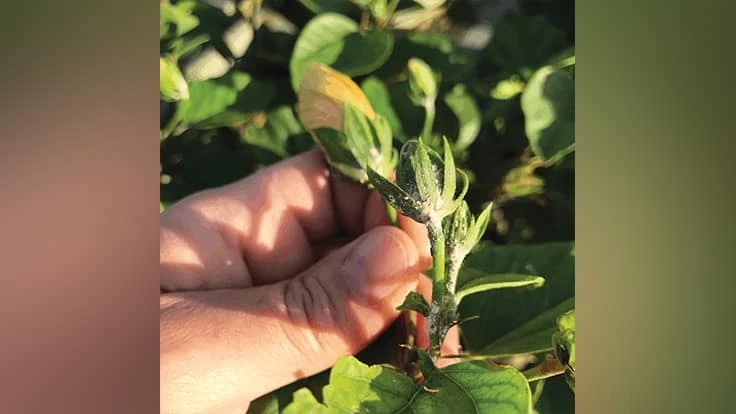

Right now, the Bayer Green Solutions team is encountering a lot of mealybugs issues in U.S. greenhouses, says Technical Specialist Aaron Palmateer, Ph.D.
“That seems to be the reoccurring issue everywhere I go. Growers often get plant material coming offshore from these tropical areas where pest pressure is high and mealybugs are everywhere,” he says. “They are just notorious hitchhikers and, just by the waxy outer-coating they have, it’s hard to find chemistry that can get to the right places and be effective enough to kill them.” Palmateer adds that in places like Florida — where he is based — there can also be native mealybug populations for growers to contend with.
Recently, Palmateer was visiting a hibiscus grower dealing with mealybugs and working with that grower to find a solution. As an example of how challenging the problem can be, he says the mealybugs were getting the bud of the hibiscus. In other instances, they are hiding in the leaves of the plant or any small, tight area they can find. As a result, Palmateer says growers have developed unorthodox solutions. Some, he said, have taken to developing bottom sprayers for their insecticides.
“If they have a rampant infestation or an isolated population, growers will send somebody in with a backpack sprayer, but put a nozzle that actually is facing upwards so it can be put under the canopy and get contact on the bottom side of the leaves,” he says.
Palmateer says Bayer has two solutions for combating mealybugs with insecticides made with systemic chemistry that are not neonicotinoids. One product growers can use is Altus, which, according to Bayer testing, is proven to work better as a foliar spray as opposed to a drench against mealybugs. The product he recommends to use as a drench against mealybugs is Kontos, according to Bayer testing. The key to finding the right product, Palmateer says, is understanding what the breadth of the problem is and what application method is best for the plants. He says, though, that it starts with identifying the problem and turning to the most proven solutions available. Bayer can help growers do that with on-site visits and a strong insecticide portfolio. The company has a cost estimate calculator available on its website so growers can estimate how much applying a certain chemical would cost for a specific space.
“When you’ve got a pest that is notorious for getting into the hard-to-reach places, systemic chemistry is going to be the cat’s meow so to speak,” Palmateer says.

Explore the March 2020 Issue
Check out more from this issue and find your next story to read.
Latest from Greenhouse Management
- Anthura acquires Bromelia assets from Corn. Bak in Netherlands
- Top 10 stories for National Poinsettia Day
- Langendoen Mechanical hosts open house to showcase new greenhouse build
- Conor Foy joins EHR's national sales team
- Pantone announces its 2026 Color of the Year
- Syngenta granted federal registration for Trefinti nematicide/fungicide in ornamental market
- A legacy of influence
- HILA 2025 video highlights: John Gaydos of Proven Winners





